Astronomy:HR 6902
From HandWiki
Short description: Star system in the constellation Ophiuchus
 Visible, blue and ultraviolet light curves for an eclipse of V2291 Ophiuchi, adapted from Griffin et al. (1995)[1] | |
| Observation data Equinox J2000.0]] (ICRS) | |
|---|---|
| Constellation | Ophiuchus |
| Right ascension | 18h 25m 38.799s[2] |
| Declination | +08° 01′ 55.23″[2] |
| Apparent magnitude (V) | +5.64[3] |
| Characteristics | |
| Spectral type | G9IIb / B8V |
| Variable type | Zeta Aurigae-type |
| Astrometry | |
| Proper motion (μ) | RA: -4.07 ± 0.54[2] mas/yr Dec.: -6.34 ± 0.31[2] mas/yr |
| Parallax (π) | 4.14 ± 0.41[2] mas |
| Distance | 790 ± 80 ly (240 ± 20 pc) |
| Absolute magnitude (MV) | –1.33[3] |
| Details | |
| Mass | 3.86/2.95[4] M☉ |
| Radius | 33/3[4] R☉ |
| Luminosity | 562/146 L☉ |
| Temperature | 4900/11600[4] K |
| Orbit | |
| Period (P) | 1.055[4] yr |
| Semi-major axis (a) | 1.96[4] AU |
| Eccentricity (e) | 0.311[4] |
| Inclination (i) | 87[4]° |
| Other designations | |
| Database references | |
| SIMBAD | data |
HR 6902 (also designated V2291 Oph) is a binary system located 790 light years away[2] from the Sun in the Ophiuchus constellation. The system includes an orange bright giant star and a B-type main sequence star, forming an eclipsing binary of Zeta Aurigae type. The system is also surrounded by a warm circumstellar envelope and the spectra show silicon and carbon absorption up to a distance of 3.3 giant radii.[4]
References
- ↑ Griffin, R. E. M.; Marshall, K. P.; Griffin, R. F.; Schroeder, K. P. (September 1995). "Optical spectra of ζ Aurigae binary systems. VII. The 1987 and 1989 eclipses of HR 6902". Astronomy and Astrophysics 301: 217–230. Bibcode: 1995A&A...301..217G. https://ui.adsabs.harvard.edu/abs/1995A&A...301..217G. Retrieved 4 February 2022.
- ↑ Jump up to: 2.0 2.1 2.2 2.3 2.4 2.5 van Leeuwen, F. (2007). "Validation of the new Hipparcos reduction". Astronomy and Astrophysics 474 (2): 653–664. doi:10.1051/0004-6361:20078357. Bibcode: 2007A&A...474..653V. http://www.aanda.org/index.php?option=com_article&access=bibcode&Itemid=129&bibcode=2007A%2526A...474..653VFUL. Vizier catalog entry
- ↑ Jump up to: 3.0 3.1 Jasniewicz, G. et al. (February 1999), "Late-type giants with infrared excess. I. Lithium abundances", Astronomy and Astrophysics 342: 831–838, Bibcode: 1999A&A...342..831J
- ↑ Jump up to: 4.0 4.1 4.2 4.3 4.4 4.5 4.6 4.7 Kirsch; Baade, R.; Reimers, D. (2001). "The warm circumstellar envelope and wind of the G9 IIb star HR 6902". Astronomy and Astrophysics 379 (3): 925–935. doi:10.1051/0004-6361:20011117. Bibcode: 2001A&A...379..925K.
 |

